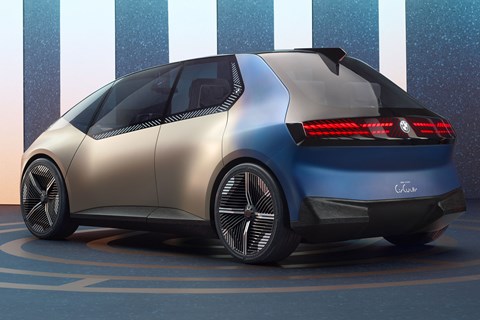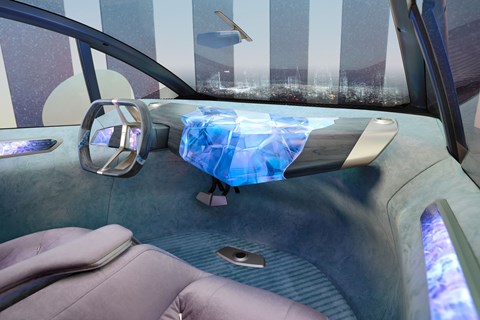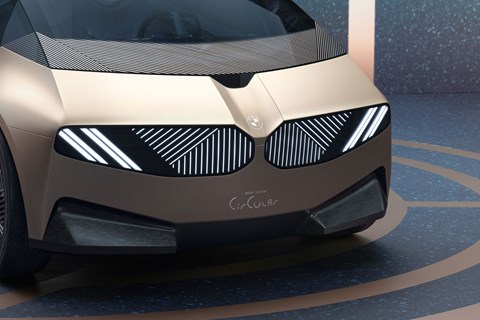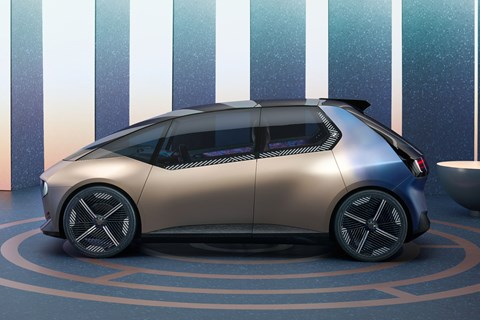► Blue-sky city car for 2040
► i3-style study into sustainable, compact luxury
► Recycled and recyclable
The i3’s back! Wait, is the i3 back?! Well, yes and no. BMW’s new i Vision Circular clearly wouldn’t exist without the steady-selling but long-lived i3, and the two are similar in size and remit. But this is a concept, pure and simple: a 4-metre-long ideas bubble.
It won’t go into production, certainly not in any form true to this wild concept. But its ideas and design will influence next-gen small BMW EVs – Munich’s currently mulling an i1 and iX1 crossover. It’s one of the trio of influential concept cars that culminated in the BMW Vision Neue Klasse shown at the 2023 IAA Munich motor show.
What are the big ideas?
One is an idea we can all get behind: to show that even in a digital-first, ride-sharing and overwhelmingly urban future of meat-free burgers, there’s still a place for what BMW’s design boss Domagoj Dukec calls ‘mankind’s greatest achievement’: the car.
Electrification is one element of this futureproofing (and clearly we’re talking electrification festooned with asterisks… so long as the hardware contains no rare earths, that its materials are recyclable, that the power is generated sustainably… all of which apply here, naturally), as is carbon-neutral manufacturing.

But i Vision Circular is also right on the front line where car meets social acceptance. With attitudes changing fast and anti-car sentiment growing, this starts to feel like a very real need. Forget regulation: what if driving an M5 may soon see you pelted with rotten fruit? It’s one reason supercar makers are going hybrid: the haters are less inclined to hate if your Artura can glide through town and out of sight on silent electric power.
‘Cars get a lot of criticism. In Europe, big cities want to ban them,’ says BMW’s Dukec. ‘But the car is the ultimate freedom machine. Even somebody who lives 100 per cent ecologically would, I think, admit that your own private space is nicer than being pressed in [to public transport] with 100 other people. By taking responsibility, the car can have a future.’
Any clever stuff?
Mainly it’s about the kind of rock-solid green powertrain credentials that will underpin BMW’s EVs (e-motors without rare earths and sustainably manufactured batteries), backed up by design and engineering that treads lightly.
The car uses reclaimed materials, quick-release fasteners for many of the key sub-assemblies, single-material design, no adhesives, 3D printing to reduce waste, and an almost Lotus-like fixation on simplification, to save weight and ease recycling.

But spending time here won’t be the automotive equivalent of living in sacrifice in some wattle-walled off-grid squalor. The roof is glass, with the windscreen header pulled back to create a light, airy space. Lounge-style seats and the car’s signature colour, light gold, bring the luxe, as does the crystal-bodied futuristic take on iDrive (the windscreen itself forms the HUD), wood from certified sources (the steering wheel is pressed from a wood powder), thick carpets of recycled plastic and lamps that served as iX iDrive controllers in their first life.
It’s still a luxury car, just one you don’t have to feel guilty about owning (or nervous about parking).
‘The real challenge is creating something desirable to everyone, not just those with a conscience,’ explains Dukec. ‘There are some buyers who are thinking, “I don’t want to save the planet – I just want to reward myself for my achievements.” Luxury and sustainability can happily co-exist.’
The exterior is – different…
Not universally loved for his front ends, this is one of Dukec’s more successful efforrts.
Dukec: ‘This car has 80% fewer parts than most, but it offers more. The face is a good example of this, and we have created something iconic by bringing together the headlamps and kidney grilles.’

Badging is engraved or lasered (to reduce the part count), and digital face opens up possibilities. ‘You replace chrome with light, and via animation you can become more useful, communicating the charging state of the car, for example. It’s no longer just an empty icon.’
Instead of paint over virgin aluminium, the car dazzles with a light-gold anodised treatment to its secondary-use aluminium skin. Elsewhere the steel is heat-treated to a contrasting blue-ish purple. The wheels – open at the centre for cooling, solid nearer the rims for low drag – look complex but are made from a single material, an approach used again and again through the car to facilitate easy recycling.
So, BMW isn’t giving up on the car just yet
No way. Dukec: ‘This isn’t about teaching people that their lives have to change; that they must give something up. It’s our responsibility to create something more enjoyable that it is almost completely sustainable. Then society and government can say, “Okay, you don’t take anything away – there are no negatives. And yet what you’re offering gives something back.” That was the idea of this car.’
